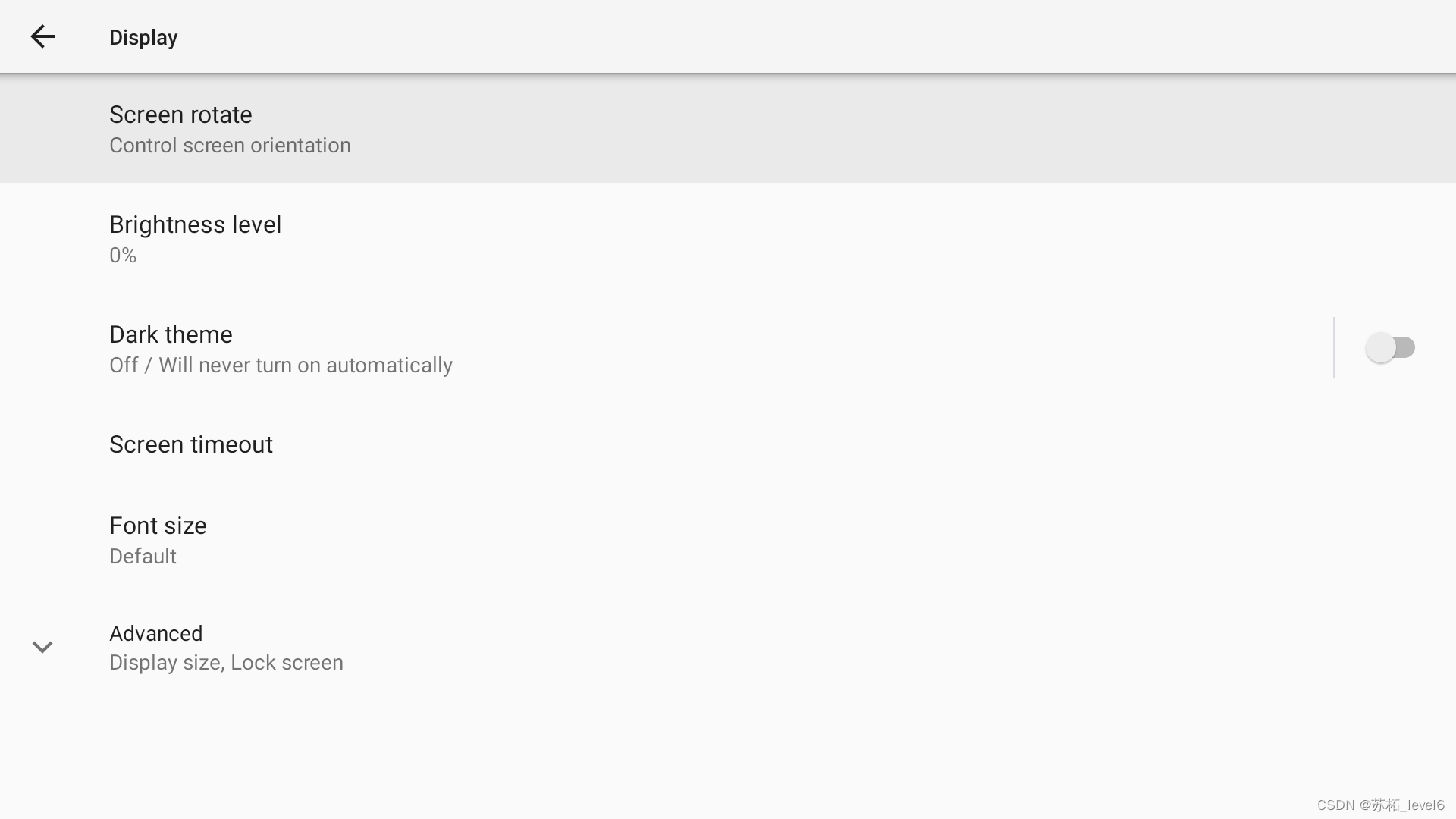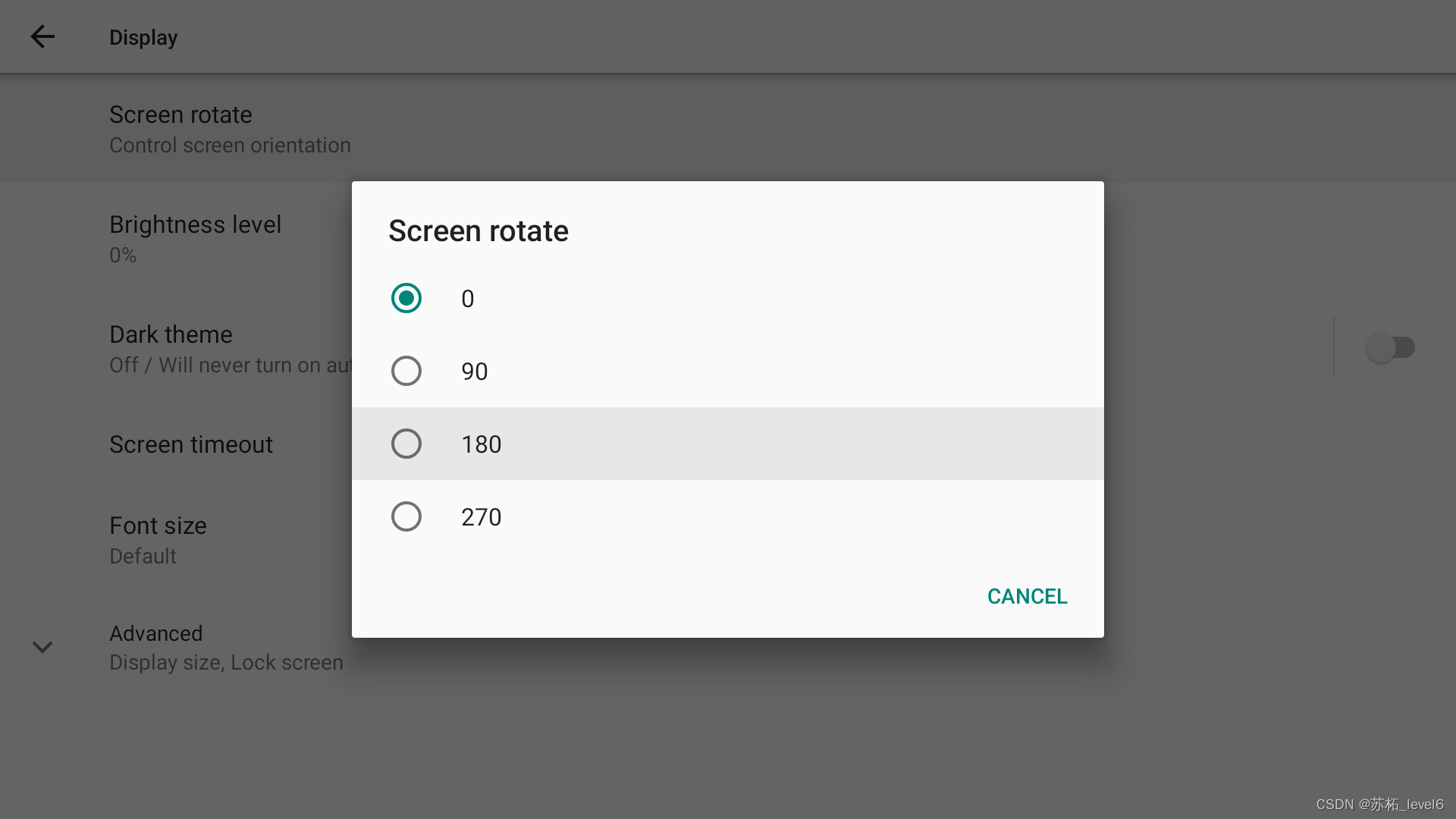前言
这里是客户要求添加按钮以实现屏幕旋转。屏幕旋转使用adb的命令很容易实现:
#屏幕翻转
adb shell settings put system user_rotation 1
#屏幕正常模式
adb shell settings put system user_rotation 0
这里的值可以是0,1,2,3 的任意一个。我这里没有陀螺仪,所以只需要这个命令就够了。更多的可以参考android 通过adb shell命令旋转Android屏幕朝向方向
但是这有个缺陷,就是开机的动画不能随着设置好的屏幕方向旋转
图片效果


代码
- 首先在资源配置文件中定义我们需要用到的字段,以供后面国际化适配的时候更方便
b/packages/apps/Settings/res/values/strings.xml
@@ -2706,6 +2706,10 @@
+ <!-- Screen rotate title-->
+ <string name="screen_rotate_title">Screen rotate</string>
+ <!-- Screen rotate summary-->
+ <string name="screen_rotate_summary">Control screen orientation</string>
添加了两个字段,分别是screen_rotate_title screen_rotate_summary
- 然后配置我们的四个选项值
packages/apps/Settings/res/values/arrays.xml
@@ -1501,4 +1501,24 @@
<item>@string/rtt_settings_always_visible</item>
</string-array>
+ <!-- Screen rotate settings. These are shown in a list dialog. -->
+ <string-array name="screen_rotate_entries">
+ <item>0</item>
+ <item>90</item>
+ <item>180</item>
+ <item>270</item>
+ </string-array>
+
+ <!-- Do not translate. -->
+ <string-array name="screen_rotate_values" translatable="false">
+ <!-- Do not translate. -->
+ <item>0</item>
+ <!-- Do not translate. -->
+ <item>90</item>
+ <!-- Do not translate. -->
+ <item>180</item>
+ <!-- Do not translate. -->
+ <item>270</item>
+ </string-array>
+
- 在xml中增加我们需要的List按钮,我这里放在了settings——display界面。
packages/apps/Settings/res/xml/display_settings.xml
+ <ListPreference
+ android:key="screen_rotate"
+ android:title="@string/screen_rotate_title"
+ android:summary="@string/screen_rotate_summary"
+ android:persistent="false"
+ android:entries="@array/screen_rotate_entries"
+ android:entryValues="@array/screen_rotate_values"
+ settings:controller="com.android.settings.display.ScreenRotatePreferenceController"/>
+
- 写Controller文件,就是我们上一步设置的
com.android.settings.display.ScreenRotatePreferenceController
package com.android.settings.display;
import android.content.Context;
import android.provider.Settings;
import android.view.Surface;
import androidx.preference.ListPreference;
import androidx.preference.Preference;
import androidx.preference.PreferenceScreen;
import com.android.settings.core.BasePreferenceController;
import com.android.settings.core.PreferenceControllerMixin;
import com.android.settingslib.core.AbstractPreferenceController;
import android.util.Log;
import android.content.Intent;
public class ScreenRotatePreferenceController extends BasePreferenceController implements
Preference.OnPreferenceChangeListener, PreferenceControllerMixin {
public static final String KEY_SCREEN_ROTATE = "screen_rotate";
private ListPreference mScreenRotatePreference;
public ScreenRotatePreferenceController(Context context, String preferenceKey) {
super(context, preferenceKey);
}
@Override
public int getAvailabilityStatus() {
return AVAILABLE;
}
@Override
public void displayPreference(PreferenceScreen screen) {
super.displayPreference(screen);
mScreenRotatePreference = (ListPreference) screen.findPreference(KEY_SCREEN_ROTATE);
if (mScreenRotatePreference != null) {
mScreenRotatePreference.setOnPreferenceChangeListener(this);
int index = Settings.System.getInt(mContext.getContentResolver(), Settings.System.USER_ROTATION, 0);
mScreenRotatePreference.setValueIndex(index);
}
}
public void setScreenRotation(String value) {
int rotation = 0;
switch (value) {
case "0":
rotation = Surface.ROTATION_0;
break;
case "90":
rotation = Surface.ROTATION_90;
break;
case "180":
rotation = Surface.ROTATION_180;
break;
case "270":
rotation = Surface.ROTATION_270;
break;
}
Settings.System.putInt(mContext.getContentResolver(), Settings.System.USER_ROTATION, rotation);
}
@Override
public boolean onPreferenceChange(Preference preference, Object objValue) {
final String key = preference.getKey();
if (key.equals(KEY_SCREEN_ROTATE)) {
setScreenRotation((String) objValue);
return true;
}
return false;
}
}
- 把上面这个加到DisplaySettings.java里面
packages/apps/Settings/src/com/android/settings/DisplaySettings.java
@@ -32,6 +32,7 @@ import com.android.settings.display.TapToWakePreferenceController;
import com.android.settings.display.ThemePreferenceController;
import com.android.settings.display.TimeoutPreferenceController;
import com.android.settings.display.VrDisplayPreferenceController;
+import com.android.settings.display.ScreenRotatePreferenceController;
import com.android.settings.search.BaseSearchIndexProvider;
import com.android.settingslib.core.AbstractPreferenceController;
import com.android.settingslib.core.lifecycle.Lifecycle;
@@ -90,6 +91,7 @@ public class DisplaySettings extends DashboardFragment {
controllers.add(new ShowOperatorNamePreferenceController(context));
controllers.add(new ThemePreferenceController(context));
controllers.add(new BrightnessLevelPreferenceController(context, lifecycle));
+ controllers.add(new ScreenRotatePreferenceController(context, ScreenRotatePreferenceController.KEY_SCREEN_ROTATE));
return controllers;
}






















 1119
1119











 被折叠的 条评论
为什么被折叠?
被折叠的 条评论
为什么被折叠?








